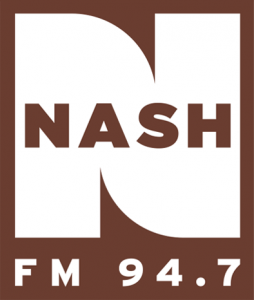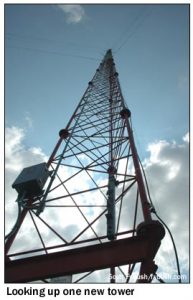NorthEast Radio Watch 12/8/2025: Cichon’s Back in Buffalo
In this week’s issue… Veteran newsman returns - Remembering NY's Leitner, RI's Jones - CT AM saved - Maine AM moves - "Indie" adds suburban signals
In this week’s issue… Cumulus Sales: What’s Next – Cox finds a buyer – Toronto’s JAZZ.FM gets a new board – Remembering LI’s Ottone, WFMU’s Burns, WJIB’s Mehrman
By SCOTT FYBUSH
 *Well, that was a Wednesday shocker, wasn’t it? As you read in our NERW Extra – and in the rest of the industry press, too – Cumulus’ surprise news that it was selling several big signals, including NEW YORK‘s WPLJ (95.5), to EMF and then swapping several others, including clustermate WNSH (94.7 NASH FM) to Entercom, was probably the biggest seismic jolt to the radio business since Entercom’s purchase of CBS Radio.
*Well, that was a Wednesday shocker, wasn’t it? As you read in our NERW Extra – and in the rest of the industry press, too – Cumulus’ surprise news that it was selling several big signals, including NEW YORK‘s WPLJ (95.5), to EMF and then swapping several others, including clustermate WNSH (94.7 NASH FM) to Entercom, was probably the biggest seismic jolt to the radio business since Entercom’s purchase of CBS Radio.
We start this week’s (slightly holiday-delayed) regular edition of NERW by unpacking some of the details of the deal, including Entercom’s plan to rework the 94.7 signals, the future of the “NASH” branding and what might (or might not) be next on the block for Cumulus.

As we announced a few weeks ago, the 2026 edition of the Tower Site Calendar will be the last.
We began publishing it 25 years ago, and the broadcast landscape is radically different now.
Radio World just ran an excellent article about us if you want to know more.
Once it’s gone, that’s it. We won’t be printing any more.
Thank you to everyone who saw our announcement and rushed to buy it. We appreciate you.
(There are some calendars from previous years if you want more of a tower photo fix — all under $5.)
But don’t wait to get this year’s Tower Site Calendar — buy it now!
We are selling the Broadcast Historian’s Calendar again this year, but we have that in an even smaller quantity — definitely don’t hesitate for that.
And visit the Fybush Media Store to check out our selection of books and videos, too!
*The price: For WPLJ and five other Cumulus FMs, EMF is paying $103.5 million. It’s easy to shorthand that as “just over $20 million per station,” but that’s not quite fair, unless you value WPLJ and Washington’s WRQX (107.3), the two biggest signals in the deal, just the same as their much smaller sisters in places like Syracuse (class A WXTL 105.9) or Savannah, Georgia.
 In practice, it’s probably fairer to assume that WPLJ alone makes up at least $40 million of the deal and maybe even a bit more. That’s the same price that Cumulus paid back in 2012 for the 94.7 signal in New York, now WNSH – and given that station values overall have stayed at best flat since then, that’s probably as good a deal as Cumulus was going to get, given its need to sell off pieces of its station holdings to help address what’s still a $1.1 billion pile of debt.
In practice, it’s probably fairer to assume that WPLJ alone makes up at least $40 million of the deal and maybe even a bit more. That’s the same price that Cumulus paid back in 2012 for the 94.7 signal in New York, now WNSH – and given that station values overall have stayed at best flat since then, that’s probably as good a deal as Cumulus was going to get, given its need to sell off pieces of its station holdings to help address what’s still a $1.1 billion pile of debt.
And for EMF, as pretty much the only buyer in the marketplace right now with ready cash looking for single signals, it’s a buyer’s market. If $40 million or so really is the price tag on WPLJ’s full-class B signal from the Empire State Building, that compares more than favorably with the $15 million EMF paid a few years ago for 96.7 up in the northern suburbs, the far-from-full-market class A signal that’s currently doing K-Love as WKLV, Port Chester.
(We still believe the WKLV calls and K-Love format will inevitably move to 95.5 once the sale closes, with 96.7 likely taking on EMF’s secondary Air 1 format.)
For Entercom, meanwhile, it’s the sort of no-cash-involved swap that the tax accountants love – it gets that coveted fifth FM for its New York cluster, along with two more signals in Springfield, Massachusetts, in exchange for two FMs and an AM in Indianapolis. If that seems tipped a little in Entercom’s favor, it probably is – but it’s also not a bad deal for Cumulus, which seems to be turning its focus to building the biggest clusters it can in medium markets. In Indianapolis, the addition of Entercom’s potent WZPL and WNTR to Cumulus’ existing three FMs makes Cumulus one of just three big commercial groups in town, squaring off against big iHeart and Emmis-owned clusters.
*Entercom’s technical changes: When Cumulus bought 94.7 from Family Stations back in 2012, we spent a lot of time in this space speculating about how it might use its common ownership with WMAS (94.7) up in Springfield to fix a longstanding signal issue. Unlike the other class B FMs in New York, what’s now WNSH was long ago locked into using a transmitter site up on First Mountain in New Jersey, 15 miles west of Manhattan, resulting in a less-than-optimal signal in the outer boroughs of New York City and out toward Long Island and southern Connecticut.
The basic circumstances haven’t changed since then. WNSH and WMAS remain short-spaced under a grandfathering clause, meaning they can’t increase the amount of interference they send toward each other. Then there’s Connoisseur’s WWSK (94.3 Smithtown) out on Long Island. While most of the class A stations surrounding the city are grandfathered under pre-1964 allocation rules to their second-adjacent neighbors (that’s how Cumulus was able to move what’s now WNBM 103.9 to the Bronx, for instance, and how WWSK co-exists with WNYC-FM 93.9 in Manhattan), that 94.3 signal was fully spaced to 94.7 in Newark back in 1964 – and so WNSH has to follow current spacing rules with respect to WWSK today.
While Cumulus never made any moves while it owned WNSH (in part because its contract with Family Stations specified extra payments that would have to be made if 94.7 upgraded), that clause expired last year, and so Entercom was ready to make its filing as soon as the ink was dry at the FCC on the sale contract.
Here’s the current plan: up in Springfield, WMAS plans to install a directional antenna at its current transmitter site along the Connecticut River. It will remain at 50 kW/55m, but with a big notch to the southwest, pulling its contours in considerably toward New York while just barely maintaining the requisite 70 dBu signal over its city of license, Enfield, Connecticut.
 In New Jersey, meanwhile, WNSH will leave First Mountain after 72 years there at two different nearby tower sites, trading its present 23.5 kW/207m class B signal for 40 kW/166m from a site that’s new to FM use in the market: a new antenna to be mounted 600 feet up on one of the three AM towers at the WOR (710) site in the Meadowlands.
In New Jersey, meanwhile, WNSH will leave First Mountain after 72 years there at two different nearby tower sites, trading its present 23.5 kW/207m class B signal for 40 kW/166m from a site that’s new to FM use in the market: a new antenna to be mounted 600 feet up on one of the three AM towers at the WOR (710) site in the Meadowlands.
That’s an easier deal to make, we’re sure, now that the site is owned not by WOR itself but by Vertical Bridge.
So what will the new 94.7 signal look like from East Rutherford? It will be somewhat weaker into central New Jersey, which will alleviate some current short-spacing to WPST (94.5 Trenton). It will have lots and lots of “grunt” (as one of our consultant friend puts it) toward the west side of Manhattan, where it will be one of the strongest signals on the dial.
But at less than 200 meters above sea level, how will the new 94.7 fare at penetrating the wall of concrete and steel that is midtown Manhattan? With an ever-growing number of super-tall buildings poking up into the sky, we wonder what sort of multipath woes will afflict the new 94.7 signal on the east side and into Brooklyn, Queens and Long Island. And we wonder, too, whether this is really Entercom’s end game – or whether there’s yet a deal to be made with WWSK to bring 94.7 all the way across the Hudson and into Manhattan.
*Intellectual property: The sale contract keeps the “NASH” intellectual property in Cumulus’ hands, which means there will at least be branding changes for WNSH and for “NASH ICON” WHLL (1450) up in Springfield. Will Entercom stick with country when it assumes operation of 94.7 under an LMA March 1? In the short term, we’re guessing that’s a yes – but in the long term, we suspect the choice will be between either the country format that’s unique in the market (and thus draws record-label money), or taking one of Entercom’s all-news stations, WCBS (880) or WINS (1010), to an FM simulcast. (Read Lance Venta’s speculation in RadioInsight on this matter, too…)
The contract doesn’t keep the WPLJ calls with Cumulus. After 48 years on the air in New York City (save for a brief interruption as “WWPR” in the 80s), those heritage calls will likely fade away – but then, the heritage they possess is largely linked to WPLJ’s old rock format, and that’s been gone for more than three decades now. Will Entercom pick up any WPLJ staffers and try to use them to bring that station’s audience over to its close format competitor, WNEW (102.7)? We’d bet on “yes” for that.
 *And as for Cumulus? Once these deals close, Cumulus will be left with just two New York City signals, talk WABC (770) and urban AC WNBM (103.9 Bronxville).
*And as for Cumulus? Once these deals close, Cumulus will be left with just two New York City signals, talk WABC (770) and urban AC WNBM (103.9 Bronxville).
That’s not much of a cluster at all, and speculation started swirling right away about who might be angling to buy those stations. Would Salem want WABC’s big 50,000-watt signal and syndicated offerings (including Rush Limbaugh and Sean Hannity) to bolster its own WNYM (970 the Answer)? Sure it would, and that could yet happen. But it’s equally possible that a slimmed-down Cumulus could carve out a little studio space for WABC and WNBM at its corporate headquarters, retain their revenue flow and still lose the considerable cost of maintaining their current 2 Penn Plaza studio/office space. (Which is to say – we simply don’t know which way those stations go next, if we’re being honest.)
*Elsewhere in the Empire State, there’s a cluster of signals missing in the southern tier, where Andrulonis Media (the renamed Colonial Media + Entertainment) has taken WVTT (96.7 Portville) and Olean translators W256BQ (99.1) and W254BQ (98.7) silent. Andrulonis tells the FCC that the tower lease on the site above Olean has expired, and a new lease at a different site is being negotiated.
*On Long Island, Bob Ottone was a radio fixture for decades. “Bullet Bob” was at WGLI (1290 Babylon) in the late 1960s and was part of the “Super 6” top-40 DJ crew at WGBB (1240 Freeport) in the 1970s. Ottone also worked at New York’s WNEW and at ABC television, but perhaps his biggest mark on Long Island radio was made during his 23 years managing WXBA (88.1 Brentwood), the Brentwood High School-based student/community station he ran from 1980 until his retirement in 2002. Ottone encouraged an entire generation of new radio people during his time at WXBA, and he stayed in front of the mic even after retiring, becoming the stadium announcer for the Long Island Ducks independent minor-league baseball team, where he was getting ready for the start of a new season when he died early Sunday morning. Funeral services will be held Friday, with a memorial gathering to take place later this year.
 *It’s a sad week at one of NEW JERSEY‘s most distinctive radio shows, the long-running freeform talk-and-music fest that is the “Glen Jones Radio Programme featuring X. Ray Burns” on WFMU (91.1 East Orange).
*It’s a sad week at one of NEW JERSEY‘s most distinctive radio shows, the long-running freeform talk-and-music fest that is the “Glen Jones Radio Programme featuring X. Ray Burns” on WFMU (91.1 East Orange).
Burns, whose real name was Ken Green, died Feb. 10 after spending the last few months fighting an advanced form of lung cancer. The news of Burns’ death came during the show’s Sunday timeslot, forcing Jones to break the news to his listeners midway through the three-hour broadcast; he’d opened the show that day by telling listeners for the first time that Burns was ill.
Burns, a real estate appraiser by day, had been Jones’ sidekick on the show for more than 30 years. (There’s a GoFundMe to support Burns’ wife, Sharon, as she tries to pay the medical bills from his illness.)
 *After months and months of speculation, we now know who’s buying Cox’s slate of TV stations, which in our region includes signals in western PENNSYLVANIA (NBC affiliate WPXI 11 in Pittsburgh) and eastern MASSACHUSETTS (Fox affiliate WFXT, aka “Boston 25.”)
*After months and months of speculation, we now know who’s buying Cox’s slate of TV stations, which in our region includes signals in western PENNSYLVANIA (NBC affiliate WPXI 11 in Pittsburgh) and eastern MASSACHUSETTS (Fox affiliate WFXT, aka “Boston 25.”)
The answer turns out to be New York-based venture capital firm Apollo Global Management, which struck a deal last week to buy a majority stake in all of Cox’s 13 TV stations, as well as its newspaper/radio cluster in Dayton, Ohio. (Cox will apparently retain sole ownership of its remaining radio stations, including WBLI and WBAB on Long Island.)
The terms of the deal haven’t been announced yet, but here’s what we do know: Cox says its current management team will stay in place, so we’re not expecting major changes at either WPXI or WFXT.
What Apollo seems to be most interested in is the prospect of pulling more retransmission-consent money out of cable and satellite operators who carry the Cox stations. Buried in the Apollo announcement was news that the venture capitalists have also reached a deal to buy Northwest Broadcasting, a small private group that owns Fox affiliates WSYT (Channel 68) in Syracuse and WICZ (Channel 40) in Binghamton, as well as a cluster of stations out west. Northwest went through a carriage dispute a few years ago that won it a favorable position against cable operators, and Apollo apparently hopes to leverage that deal for the Cox stations as well.
And there’s more – Apollo is also positioning itself as a potential buyer for stations that will have to be spun from the pending Nexstar/Tribune deal, in markets that include Wilkes-Barre/Scranton, Harrisburg and possibly even New York, where there’s word Apollo could end up with Tribune’s WPIX (Channel 11).
 *We’ll do our full “Baseball on the Radio” coverage next month, but in the meantime there’s big news from the Bay State, where the World Champion Boston Red Sox will be filling their radio booth with a chorus of new voices alongside play-by-play veteran Joe Castiglione.
*We’ll do our full “Baseball on the Radio” coverage next month, but in the meantime there’s big news from the Bay State, where the World Champion Boston Red Sox will be filling their radio booth with a chorus of new voices alongside play-by-play veteran Joe Castiglione.
Castiglione has signed an extension with flagship WEEI-FM (93.7 Lawrence), and this season the rotation of color commentators working the booth with him will include Sean McDonough, the ESPN broadcaster who spent many years in the Sox/NESN TV booth; Mario Impemba, who’d been in the Detroit Tigers’ TV booth; Josh Lewin, the former Mets radio voice who’s now based in San Diego at Entercom sister KWFN (97.3 San Diego); Lou Merloni and Dale Arnold from WEEI; ESPN’s Chris Berman – and even Dave O’Brien, Castiglione’s former radio partner who now works Sox TV. (He’ll move to the radio booth when the Sox are on national TV.)
*And we’re saddened to report the death of Bob Mehrman, who served as morning man and public affairs director for the old WJIB (96.9), as well as working as a booth announcer for WBZ-TV (Channel 4) and WCVB (Channel 5). Mehrman became an anti-smoking advocate after being diagnosed with lung cancer and undergoing a laryngectomy in 1990, working with the Massachusetts Tobacco Control Program as a speaker in area schools. Mehrman died Sunday (Feb. 17) in Peabody, at 91.
 *It was an unusually busy week in CANADA‘s biggest radio market, starting with a surprise rebranding Monday morning at Stingray’s CFXJ (93.5 Toronto), which dumped its “93.5 the Move” identity to return to its original branding as “Flow 93.5.”
*It was an unusually busy week in CANADA‘s biggest radio market, starting with a surprise rebranding Monday morning at Stingray’s CFXJ (93.5 Toronto), which dumped its “93.5 the Move” identity to return to its original branding as “Flow 93.5.”
The, er, move completes a musical shift that had already taken 93.5 back to straight hip-hop from the rhythmic top-40 playlist it had adopted when it became “the Move” three years ago.
*The even bigger shift in Toronto radio, though, came at the special meeting on Friday for members of CJRT (JAZZ.FM 91), where several years of tension between the community station’s board and a dissident group of listeners and former staffers came to a head.
Amidst allegations of harassment and mismanagement staffers, the “Save JAZZ.FM” group led by Brian Hemming won the slimmest of victories, ousting the current CJRT board by a 449-440 vote and then installing its own slate of new board members by a 446-435 vote. More than 100 station donors showed up in person at the meeting (the rest voted by proxy), hearing from a group of former CJRT personalities who advocated for the ouster.
We’ll be watching closely to see what Hemming and his new board do to restore donors’ trust in the station; ousted president-CEO Ross Porter, who’d remained at CJRT with a weekend show, was still on the air there this past weekend.
[/private]
In this week’s issue… Veteran newsman returns - Remembering NY's Leitner, RI's Jones - CT AM saved - Maine AM moves - "Indie" adds suburban signals
In this week’s issue… Scripps stations face takeover - Sinclair moves more affiliations - CT stations sold - Maine AM surrendered - Remembering WVBR's Shapiro, WABC's Morgan
In this week’s issue… CT TV legend succumbs to cancer - Remembering PA's Adams - FCC still stalled by shutdown - Pittsburgh morning host exits
In this week’s issue… FCC faces reopening challenges - Veteran Boston anchor retires - Morning shift in Toronto - NYC FMs expand reach